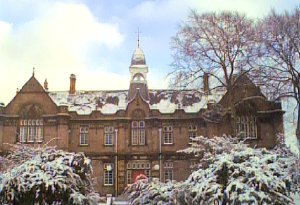As you can see, the smokehouse is really quite a small building. This is more a cottage industry than mass production!

After the brining process, the fillets are taken into the wash area where cold water is used to remove any excess solution from the fish on the trays. Each side is then hung using a metal hook and placed onto another trolley. It takes 72 sides to fill a trolley, and once each trolley is full it is wheeled into the cold kiln, where the salmon is left to dry for two hours.
When the fillets are drying in the kiln, the fires are set in the kiln boxes at the back of the Smokehouse, using oak chips from used whisky casks, oak and beech wood dust, and paper. Once the fires have started water is sprinkled over the flames in order to slow the burning process. Smoke is drawn from the kiln boxes through a small inlet in the kiln wall, where it circulates around the hanging salmon sides before escaping via a roof top chimney.
The trolleys remain in the kilns for up to 22 hours giving Spey Valley salmon its distinctive roundness of flavour. When smoking is completed the trolleys are then placed in the post smoke chill.
To be continued!





























